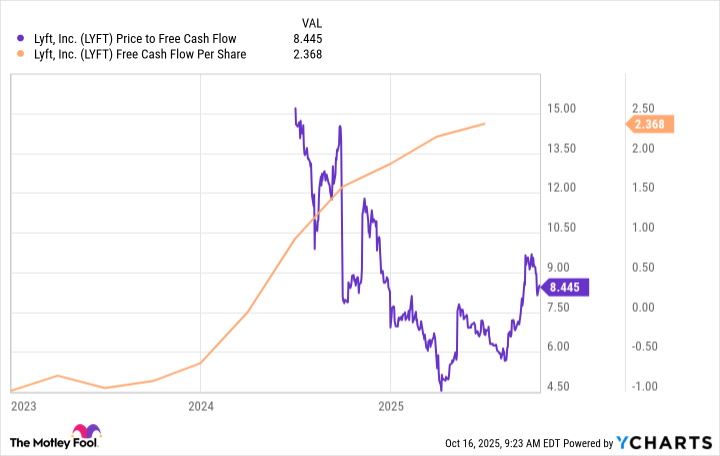An overemphasis on the risks may have brought this stock down to a valuation that’s too cheap to ignore.
California is called The Golden State. And from The Golden State comes a golden opportunity for investors. Those don’t come around very often so it’s important to not let this one slip by without at least considering it.
What should investors do when they get a golden opportunity? As investing great Warren Buffett said: “Opportunities come infrequently. When it rains gold, put out the bucket, not the thimble.”
This was echoed by Buffett’s late right-hand man Charlie Munger who said, “When you get a lollapalooza, for God’s sakes, don’t hang by like a timid little rabbit.”
To be sure, shares of this California-based company are already up 55% year to date, so it was certainly a better opportunity for investors at the start of the year. But I believe it can still be a key component of a growth-investing portfolio. And I’m talking about none other than ride-sharing platform Lyft (LYFT -1.71%).
Image source: Getty Images.
Why Lyft is a golden opportunity
I see a golden opportunity as a company with the following features: its profits are improving; its stock trades at a cheap valuation; and it’s growing nicely. Lyft shows all three.
For growth, Lyft is growing at a double-digit rate. In the second quarter of 2025, rides on its platform increased 14% year over year to an all-time high, and key underpenetrated markets such as Nashville grew at an over-20% rate. Q2 bookings also grew by double digits, and management expects 13% to 17% bookings growth for the upcoming Q3.
In short, growth is great for Lyft, and it’s continuing to plow ahead.
For profit improvement, Lyft’s CEO David Risher took over in 2023, vowing better profitability, and he’s delivered on that pledge. The company officially turned the corner with positive free cash flow on a trailing-12-month basis in 2024’s Q2 and has delivered six straight quarters of positive results.
Some of the notable changes under Risher have been an increase in sales-and-marketing spend, which has paid off with higher revenue. But corporate expenses have been largely held in place, and research-and-development expenses actually declined. The payoff is better profitability.
Finally, concerning valuation, Lyft stock trades at a mere 8 times its free cash flow. Many comparable businesses trade at a valuation that is two to three times higher than this, highlighting the bargain here.
LYFT Price to Free Cash Flow data by YCharts.
It’s rare to find a company that’s growing by double digits on the top line, making meaningful gains on the bottom line, and also trading at a discount to comparable companies. That’s why Lyft is a golden opportunity in my book.
Why some call it fool’s gold
Many investors recognize everything I’ve highlighted here but nevertheless are bearish on Lyft stock. They don’t question present results, but they do question sustainability. It’s believed that Lyft’s industry is changing and will leave it behind sooner or later.
The main catalyst for change in the ride-sharing space could be autonomous vehicles, specifically autonomous taxis. The idea is that there will be millions of autonomous taxis on the road, making Lyft’s business model irrelevant. But there are some important counterpoints to consider.
First, there could be a long road ahead before autonomous taxis fully displace the current ride-sharing model. It’s already slower to roll out than some pundits predicted. Lyft could continue for some time before this competitive risk really materializes.
Moreover, it’s premature to believe that autonomous taxis would make third-party, ride-sharing platforms obsolete. Consider that Domino’s Pizza has excelled at delivering its own pizzas for decades, but it still partnered with DoorDash for incremental revenue. It’s quite possible that autonomous taxis would still be hailed from Lyft’s app in the future.
Finally, there are parts of Lyft’s business that would directly benefit from a more autonomous future. For example, Lyft’s Flexdrive business provides management tools for fleets of autonomous taxis. This is just a single example of how Lyft could pivot in a worst-case scenario.
Riding with Lyft
Personally, I believe that investors are overemphasizing the potential risks to Lyft’s business and underappreciating the investment opportunity. There may be businesses that are growing faster, and have better profit margins or cheaper stocks. But I struggle to find a more attractive combination of these three traits than Lyft stock right now.
That’s why I see it as a golden opportunity. And it’s why I’ve personally made Lyft stock a big component of my growth stock portfolio.
Jon Quast has positions in Lyft. The Motley Fool has positions in and recommends Domino’s Pizza and DoorDash. The Motley Fool recommends Lyft. The Motley Fool has a disclosure policy.


